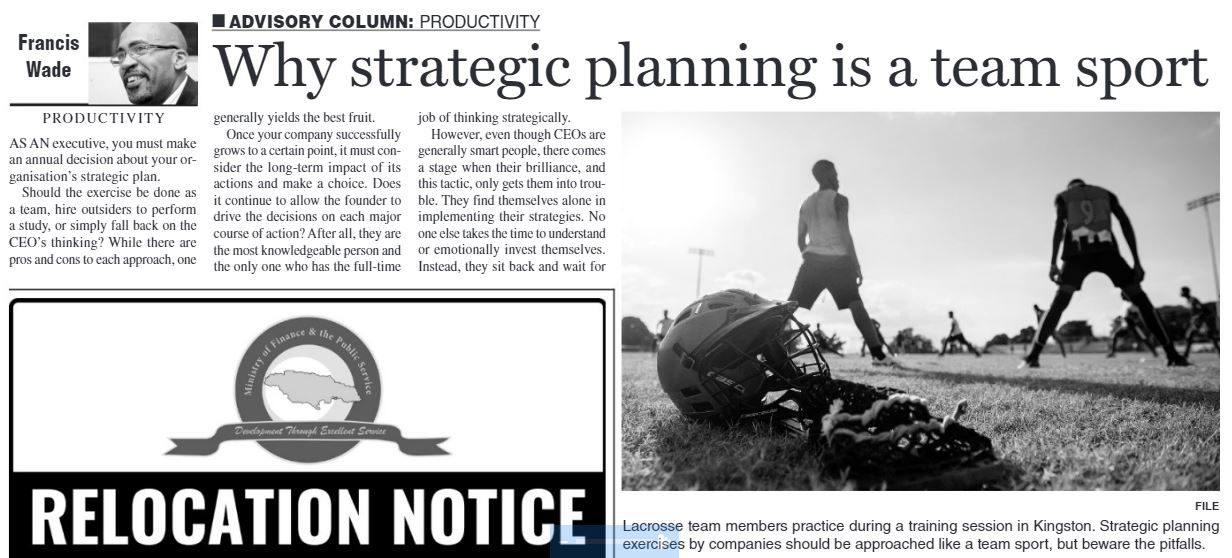As an executive, you must make an annual decision about your organization’s strategic plan. Should the exercise be done as a team, hire outsiders to perform a study, or simply fall back on the CEO’s thinking? While there are pros and cons to each approach, one generally yields the best fruit.
Once your company successfully grows to a certain point, it must consider the long-term impact of its actions, and make a choice. Does it continue to allow the founder to drive the decisions on each major course of action? After all, he/she is the most knowledgeable person, and the only one who has the full-time job of thinking strategically.
However, even though CEOs are generally smart people, there comes a stage when their brilliance, and this tactic, only gets them into trouble. They find themselves alone in implementing their strategies. No-one else takes the time to understand or invest themselves emotionally. Instead, they sit back and wait for the Boss Man/Lady to do all the big-picture thinking…as usual.
In a small company with a “Snow White” organizational structure (i.e. a single strong extrovert surrounded by introverts) this approach can work. However, an enterprise that must grow by hiring talented people will eventually run into trouble. High performers either refuse to join, or leave after a few months.
An alternate tactic is to invite in an outsider. A consulting firm willingly does all the interviews, data gathering, analysis and report writing. The result is a beautifully packaged set of strategy recommendations.
However, they have actually done their client a disservice.
By undertaking the intellectual labour themselves, they also undermine the emotional commitment. In other words, by the end of the project, they believe in their ideas more than anyone else, especially those who must implement them. Even those who originally had the ideas are sidelined as they become branded by Consulting Firm X.
But there is a third tactic. You could treat the development of the strategic plan as a team exercise, like a sport: an effort in which each person must play their part. However, there are several pitfalls to this approach that need to be avoided.
1. Impartial Facilitation
The best event to forge final decisions is a strategic planning retreat. Unfortunately, most are little more than one of two extremes: a place to air opinions of all kinds without making any commitments, or a presentation of pre-agreed decisions in which people are “encouraged“ to buy-in. Neither produces satisfying results.
Instead, the most effective retreats allow consensus to build from the bottom-up. In most cases, this is best facilitated by an outsider who allows contentious issues to be brought up in a civil way that helps your team make final, binding decisions.
These new points of agreement are the entire purpose of the activity – to craft ultimate, difficult choices that close the door on other alternatives.
2. Immediate Capture
The second pitfall is to think that a hearty discussion is sufficient. In a tiny company, this approach may work as it’s easy to share information.
However, in a larger organization, these agreements must be translated into projects or initiatives which lead to wide-spread behavior changes. To ensure that this happens, your team should document the new strategy immediately after it makes decisions.
In other words, the written substance of each strategy cannot wait to be captured until the next day. If the team waits even a few hours to translate their decisions into words, you may learn the hard way that strategic conversations have a ridiculously short shelf-life. As soon as they are explored and completed, their essence begins to fade once a new conversation commences.
The only option is for you to capture these conclusions immediately, before everyone scatters to go home.
Unfortunately, this approach is rarely taken because people believe that a fancy Strategy Report is the true final product. It’s not: the decisions your team made are far more important.
3. Instant Ownership
The last pitfall you could make is to leave the retreat without proper ownership being assigned. Overall responsibility isn’t enough: key activities may still languish due to a lack of personal accountability.
The solution is simple: assign sponsors to each of your new initiatives, even if they don’t possess subject matter expertise. Their sole job is to shepherd the project until a manager is assigned. In fact, they may only relinquish their sponsorship years after the planning event, but when they play their role well, it keeps the retreat’s momentum going.
Every sport has its peculiar conventions and practices. Avoid these pitfalls and you increase the odds that your team will win.
http://jamaica-gleaner.com/article/business/20200308/francis-wade-why-strategic-planning-team-sport

